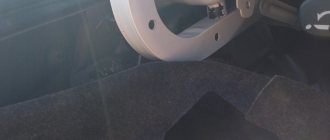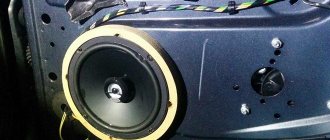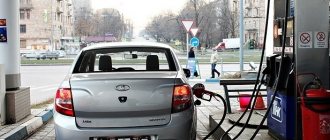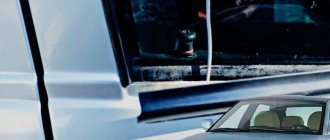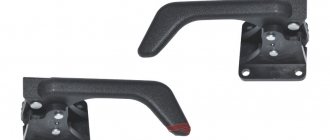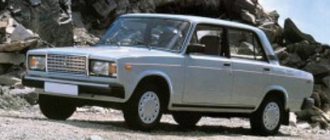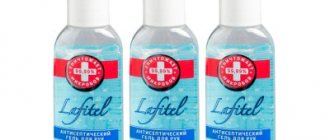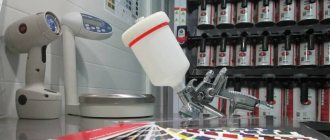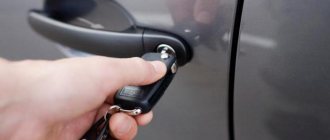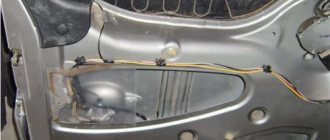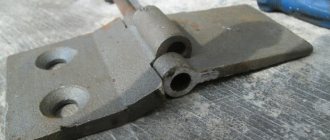Car doors are not immune to unpleasant moments that result in defects appearing on the surface in the form of scratches, cracks or dents. But if minor defects can somehow be tolerated, then it is better to straighten the dented door. Driving a car with a damaged door is both unattractive and dangerous. In case of minor damage, when the geometry of the frame is preserved and the door can be opened and closed, it is possible to straighten the car door yourself. When the frame base is damaged and the metal surface is stretched, this part will have to be replaced.
Restoring body geometry
If the result of a serious impact is a change in the geometric distances between the fixation points of the body, restoration of the geometric parameters of the car may be necessary. Doing this work with your own hands is not easy, especially if you don’t have the relevant experience.
To correct such geometry violations, you should contact specialists. And it’s not even that it’s difficult to straighten the body on your own. It’s just that such work often requires not ordinary hand tools, but special devices that are not available everywhere. It would also be useful to have such work monitored by an experienced craftsman to eliminate unnecessary errors and waste of time correcting them.
Necessary tool for straightening a car
Do-it-yourself straightening and painting of a car is done quite quickly and easily if you first watch the entire process of leveling any dents in any auto repair shop. This will give you a complete understanding of how to use the tool and from which side to approach the existing problem. In addition, you will be able to evaluate the technique used.
Like any type of work, straightening and painting a car has a number of subtleties and nuances. That is why, when straightening the front or rear fender, or car doors, it is necessary to clearly know and follow the instructions that are intended for performing straightening work.
To straighten yourself, you need to purchase the following tools:
- Straightening hammer with convex round and square heads
- Straightening hammer with flat round and square heads
- Straightening hammer flat round and convex square striker
- Straightening hammer with convex round and point strikers
- Straightening hammer large flat round and square strikers
- Spinless hammer
- Rubber hammer
- Leveling spoon
- Double-sided straightening
- Whistle straightening
- Straightening "heel"
- Straightening "paperweight"
- Angular straightening
- Spoon for internal straightening
- Universal spoon
- Pulling spoon
- Convex spoon
- Elastic shock spoon
- Impact blades
In order to pull out and then level the hard corners of the surfaces of the parts, you need to stock up on a jack. Straightening a car very often involves the use of a welding machine. It is used to weld cracks. Also, a file is often used to level the surface of the body. You can’t do without a grinding device, which includes a rubber disc and sandpaper. The paper is pressed with a nut.
Hydraulic body repair
In straightening work, hydraulics are often used - hydraulic braces and jacks, hydraulic cylinders, pumps. The hydraulic tool is included, the extension allows you to create a force of up to 5 tons. Using hydraulics, car trunks and hoods are straightened, sills are leveled, and distortions in doorways are corrected.
When is body straightening necessary?
Similar work is used in the following cases:
- When restoring the original geometry of body parts. This is the most common type of restoration work. Car straightening is used if its parts were damaged as a result of an accident or under other circumstances. Repair involves the use of welding, grinding, and fitting with special tools.
- Correction of local damage in a small area. In this case, minor damage to the body is corrected using straightening. Dents are smoothed out using a large arsenal of hammers with different geometries and coatings, applying frequent light blows to the damaged area.
- When preparing car body parts for painting. Sometimes straightening the metal is necessary to correct dents that have arisen before applying paintwork.
Parts that cannot be repaired
Note that in cases of significant tears and stretches of the metal, straightening is not possible, since it will not be able to completely restore the factory geometry of a particular part, so it is more advisable to completely replace the damaged unit.
Procedure for eliminating body defects using Pops-a-Dent
- A small shoe is attached to the body in the center of the dent. It is fixed with a special glue that comes with the tool.
- A threaded pin is screwed into the shoe, and a small plastic bridge is put on it. The bases of the bridge rest against the body of the car.
- A nut is screwed onto the stud. By pulling it up, the shoe pulls the metal outward.
After removing the dent, the shoe is removed with a special spatula. It is also included with this device.
Pops-a-Dent body repair kit
Note that the third option does not always work. In general, the driver performs all actions to eliminate body defects with his own hands at his own peril and risk. If you are not confident in your abilities, and still have some money left for a rainy day, it is better not to experiment and trust the professionals.
All of these methods are suitable for small dents. It is better to entrust deeper ones to professionals. There are now quite a lot of workshops open that use paint-free dent removal technologies. They have a special tool at their disposal to level out deeper dents from the inside. It should be noted that body repairs without painting take much less time and do not require dismantling of body parts. In addition, this type of repair is cheaper.
Tool
Do-it-yourself car body straightening is done using special tools. Their list includes:
- Straightening hammers and mallets. They are used to remove dents of various shapes and complexity. The impact head of the hammer is well polished and has a rounded surface. The tool is made of alloys of non-ferrous metals, plastic or rubber. The weight of the impact device does not exceed 200 grams. Damage to the body is eliminated using frequent gentle blows; depending on the depth of the dent and the type of metal being restored, the defect is tapped either from the edge to the center, or vice versa.
- Supports, anvils, stamps. The main purpose of this set of tools is to fix the damaged area of the body. When choosing a specific tool, they are guided by the shape and size of the dent. Depending on this, the substrate is chosen.
Backing dies, supports and anvils. Fix the damaged area of the body
It is important to consider that the shape of the support must match the shape of the damaged area. Impact blades and spoons. In addition to pulling out dents, these devices are used as impact stamps to repair serious damage.
When compressing metal sheets, spoons are used. They separate the defective areas. Levers and hooks. Devices designed to pull out a defect from the inside. The body stiffeners are used as a support for the lever. Depending on the shape and size of the dents, hooks of appropriate sizes and shapes are used. Files and sander. Level the restored surface before painting and polishing the painted area. Spotter. A device designed to perform spot welding. Used to eliminate tears and creases in metal.
Percussion
Straightening without painting is used if the damage is above average in size. To accomplish the task, rubberized mallets and hooks of different shapes are used. Using mallets, the inner surface is tapped, making it easier to repair damage. When removing paintless dents by straightening, not strong, but frequent blows are applied. At the final stage, the surface is polished.
Straightening of external elements
Provided that the load-bearing elements of the subframe and body pillars are not deformed, only external elements can be repaired. This type of work is not too expensive, you can try to do it yourself.
When straightening thin metal elements damaged over fairly large areas, wooden mallets are used. The procedure when an element is given its original shape is called knockout. Small anvils or shaped plates are used for support.
Sometimes the shape of body elements can be corrected almost completely. If a successful combination of circumstances occurs, the correction of a car part occurs even without damaging the paintwork of the surface.
You can do the knockout yourself: this is done by holding the element suspended or by placing the part on a wooden stand. In this case, be sure to use a mallet that is not made of metal. The blows are applied from the center of the damage in expanding circles, gradually moving to the outskirts of the crumpled area and undamaged metal.
After knocking out areas with sharp bends and sharp corners, a general correction of the surface of the part remains. If the damaged area has an area with a sharp angle or bend, then the drift should always start from the place of this fold.
How to straighten a car body with your own hands
To straighten the car wings, first of all, you need to remove them. After this, place the wing on a surface covered with felt. Softness is necessary to soften impacts. Lightly tap to level the surface as necessary, adjusting the blows as necessary. If at the same time the old paint comes off from the surface being treated, then this surface is prepared for painting; putty, rubbed, degreased. After this, enamel is applied.
In order to straighten the car hood or its doors, they are also removed. They are installed in the most convenient position for work and, using a special tool that penetrates under the inner lining, dents are squeezed out. In this case, a hammer will not help deal with defects. Sometimes you can warm up the damaged area, then it becomes softer and easier to correct and level.
If the dent is large, then its removal begins from the edges, where, clearly, all the stress is recorded. But a small dent, on the contrary, is removed starting from the middle. If the impact points of the hammer and the support coincide, then the damaged surface is stretched. To avoid this, the support must be held with some deviation. And the blows of the support and the hammer itself need to be alternated.
Before you begin straightening the metal, you need to establish the boundary of the defect. Tapping is carried out from the back side of the existing dent, and the support is located on the front side of the metal surface.
After straightening, the surface is felt with the palm of your hand. Two types of surface defects can form:
- the formation of depressions that cannot be eliminated by extrusion;
- the formation of bubbles that tend to move to another surface when pressure is applied to them.
To eliminate such defects, you need to draw the boundaries with chalk, and then eliminate the elongation of the metal. Depressions are removed by straightening in depth on each side of the sheet. The blows should be struck in the center and then moved to the boundaries, reducing the force of the blows. Bubbles are removed by pulling the metal together. This can only be done by thickening the metal. To do this, you need to heat several points in the bubble using an oxy-acetylene torch.
The mechanism is as follows: a certain surface is heated red-hot, while its ductility increases greatly, and the springing effect of the unheated metal contributes to shrinkage. After cooling the heated place, the metal contracts, it thickens and the bubble is eliminated. Use a wet rag for cooling.
Straightening of cold surfaces on straight sections of panels is carried out using the following tools: a base plate and a mallet. Elimination of irregularities on parts that have a non-round surface is carried out using a mallet and anvils of a special profile, or shaped plates.
- Do-it-yourself car painting straightening also includes the following steps: Leveling with putty and wiping off the putty. The last type of work must be performed using special tools, which include a plane and a block. The necessary sandpaper is attached to them.
- After this, a primer is applied to the surface of the car body. If necessary, apply anti-corrosion primer. It is used exclusively for exposed metal. After drying, a primer called a filler is applied, and only then a leveling primer is applied. The latter helps restore the required geometric shape. After this, the metal surfaces are degreased and blown off.
Nuances of straightening work
- If a dent forms on a part of the body with double metal, it will not be possible to level the surface with a hammer - it will not be possible to reach the outer iron from the inside. In this case, you can properly straighten the element using a spotter.
- If a “slam” has formed in the center of the rear/front fender or door, you can try to straighten it without using any tools - you need to sharply hit the iron from the inside with your hand. Of course, you can use a vacuum suction cup with a reverse hammer, but not everyone has this tool.
- It also happens that a body part (fender, door, hood, trunk lid) that already has traces of corrosion is damaged. It makes no sense to straighten such an element even due to poverty. It’s better to drive with this defect for now and save money for repairs and a new part. Of course, in this case we are not talking about a serious accident.
- When leveling the surface, it is better not to apply single sharp blows; you should strike lightly and often.
- There are body parts that are inexpensive, so straightening an old hood or front fender is not always justified. But there is one nuance here - many foreign cars sell non-original Chinese spare parts. If the car has an original hood, and it can be straightened, then it is better to restore it than to buy a cheap “non-original” one, which may cause problems: the iron will quickly begin to rust, and the part will be difficult to fit in its place.
Types of body straightening
Do-it-yourself body straightening requires specific knowledge and experience from the car enthusiast. Such repairs can be divided into three types:
- Correction of dents. In most cases, this is exactly the problem that many car enthusiasts face. Any impact leads to crumpling of the metal and the car requires straightening the hood or. Dents are the most common type of defect. They can be removed using the vacuum method.
Vacuum correction of dents
- Elimination of bulges. The metal of a car body does not bend in all places during an impact; in some places, the acting forces cause the metal, on the contrary, to bend. Such defects can be eliminated by straightening the car yourself using hammers.
Mechanical correction of dents using a hammer
- Local straightening. This type of do-it-yourself dent straightening involves correcting the geometry of the metal without dismantling the part, but using only technological holes in the car body.
through technological holes
Important points
The essence of the method is based on applying pressure and pulling out the dent. This restores the original geometry of the body where the damage occurred.
The PDR technique has several subtypes. The choice in favor of one or another option depends on the degree of damage, depth and size of the dent. When removing small dents, a simple set of tools is used, but for serious defects, more expensive and complex equipment is needed.
There is an important BUT. Paintless body repair is not possible in all cases. There are situations that make such work impossible. These include:
- severe deformation of the body led to the formation of cracks and creases;
- the car is more than 15 years old (the metal is tired, so restoring the PDR method may not help);
- poor quality paintwork (from the factory or after repainting by the car owner himself), due to which the layer may come off as a result of the metal being pulled out;
- the damaged area had previously been repaired using conventional straightening using a hammer, putty and paint.
Restrictions on the use of PDR technology
Reviews from some car owners sometimes amaze me. They bought themselves PDR tools and think that now they can restore literally everything. In fact, you first need to study in detail the features of the technology and its capabilities, and only then complain about the lack of results.
What I mean is that there are some areas of the car body where the use of the PDR method will be meaningless and ineffective due to objective reasons.
- Luggage frame, edges of the hood cover and doors. PDR is not relevant because it is impossible to reach the dents from the reverse side.
- There are restrictions on restoring thresholds, since these elements have a pair of walls. You can't get to them from the back. But if there are no creases, straightening is possible.
- Roof pillars with sharp creases. They also cannot be restored if dents form using a paintless method.
- Defects and distortions that formed after indirect impacts on the body.
But remember, if the paintwork has been preserved in places of damage, it has no creases or cracks, and everything is in order with the geometry of the body, then PDR will be an excellent assistant in repairs.
Metal has memory, which is what this technique is based on. With the help of tools, the master helps the body remember how the parts were located before the impact or accident, what the geometry was. This may sound a little strange, but that’s how it is.
Technology
Depending on the type of damage, different methods of restoration work are used. Before choosing a method for eliminating defects, it is necessary to inspect the working surface and properly prepare the car body for repair work:
- The surface is thoroughly washed and dried.
- The area to be restored is degreased.
- Undamaged parts are dismantled or covered with masking tape.
Car body straightening technologies:
- Regular straightening.
- Paintless vacuum restoration. Performed using Paintless Dent Repair technology.
- Hot shrinkage.
- Aluminum recovery.
Regular straightening
Straightening and painting is done by hand. The bulge is tapped with special hammers, and dents of complex shapes are removed using special hooks. Small damage is tapped from the center to the edge of the defect, large ones - vice versa. This is done in order to avoid tearing the metal at the thinnest point.
Restoration without painting
Body straightening performed using this technology is carried out without painting the restored element. A special vacuum suction cup is applied to the dent, and the metal is leveled under air pressure. However, if there are cracks on the surface, this method of eliminating defects is contraindicated.
Hot shrinkage
In severe cases, when traditional methods fail to straighten the metal, the surface is heated using a gas burner or a hair dryer. Next, using spiral movements, the metal is given its original shape.
Restoration of aluminum parts
Straightening of aluminum parts is carried out from the center of the damage to its edges. The defect is tapped with hammers or squeezed out with spoons. Straightening of the metal is not performed with a spotter; straightening is carried out from the inside of the body element. If the “cold method” is ineffective, the metal is heated to a temperature of 150-200 degrees.
Leveling with applicator
The applicator method is used if straightening from the inside is impossible.
Before starting repairs, the surface of the machine must be thoroughly degreased. Next, round or square applicators are attached to the surface with glue (along the edges of the dent). The central part of the damage is leveled using a mini-lifter or a staple with a central screw. This must be done very carefully, as you can easily “pull” the dent.
It should be noted that this pulling method does not require large material costs or special skills. It's not difficult to do this yourself.
Pulling with an applicator
The essence of editing and straightening. Equipment and tools for manual straightening and straightening
Edit
- metalworking operation for the processing of metals by pressure in order to eliminate dents, bulges, waviness, curvature, warping and other defects on workpieces and parts. This is a preparatory operation preceding further technological processing of the workpiece.
Editing is carried out when the workpiece is cold or hot (with large sections); it is performed manually or by machine.
Hot straightening is carried out at a temperature of 850... 1100 °C for steel blanks, 350...470 °C for duralumin blanks. Heating above the specified temperatures leads to overheating and then to burnout of the workpieces. Only ductile metals and alloys are subjected to straightening. Bronze and cast iron cannot be straightened.
Straightening
- metalworking operation for straightening hardened parts, as well as parts bent through a stiffener.
Elimination of defects during straightening occurs due to stretching (i.e. elongation) of one or another part of the metal of the part. Straightening is usually performed by striking the part with the toe of a hammer or a special straightening hammer
; wherein
Rice. 5.1.
Correct devices:
a
- straightening headstocks;
b
- regular slab;
c
- anvil
use straightening headstocks
(Fig. 5.1,
a).
The working part of the surface of the straightening head can be cylindrical or spherical in shape with a radius of curvature of 150...200 mm. The straightening accuracy reaches 0.05 mm.
Manual straightening is performed on steel or cast iron leveling plates
(Fig. 5.1,
b),
having a smooth and clean working surface.
The most common slab sizes are 400 x 400, 750 x 1000, 1000 x 1500 mm. The slabs are installed on metal or wooden stands with a height of 800...900 mm. Small parts are adjusted on anvils
(Fig. 5.1,
c).
A bench hammer with a round polished head is used as a tool for manual straightening (a hammer with a square head leaves dents on the workpiece); hammers with inserted strikers (Fig. 5.2, a)
from soft metals - copper, lead, and wood;
wooden hammers (mallets) (Fig. 5.2, b);
smoothers (wooden or metal bars). To straighten hardened parts, straightening hammers with radius strikers weighing 400...500 g are used (Fig. 5.2, c). In Fig. Figure 5.3 shows a straightening hammer, in the body of which a working toe made of hard alloy is mounted.
Editing the car body
Straightening is necessary to rid the surface of small but obvious bends and stretches of the body metal. The main task of straightening is to restore the shape of the surface of the part. The curvature inherent in certain body elements should be smooth, looking as if the part was stamped at the factory.
Procedure for carrying out straightening with your own hands:
- visual inspection;
- determination of the type and level of defects that have appeared;
- editing, giving parts their original shape.
To diagnose car body problems, an inspection is first carried out. If possible, use the help of specialist bodybuilders. You can also learn how straightening is carried out from the video at the end of the article.
Thermal removal of dents on doors
Do-it-yourself door repair using the heat treatment method is one of the most popular, and it is not surprising, because all the units necessary for it are inexpensive and can be purchased without any problems. So, all you need for the repair is a powerful hair dryer and a can of compressed air. When choosing a hair dryer, you should take into account that it will need to have sufficient power to heat the problem area of the door to the required temperature. Therefore, it is best to give preference to industrial heat guns.
Advantages and disadvantages of vacuum straightening
Vacuum straightening of a car has an undeniable advantage over conventional straightening. First of all, this is the time spent on straightening dents. The work goes much faster than when using traditional straightening methods. The second advantage is that the paintwork of the body is not damaged: there is no need to putty and repaint it.
But a significant drawback is the fact that only a few service stations perform such straightening, and there are very few craftsmen who can do it well. In addition, not every dent can be straightened using vacuum straightening.
Straightening a car body in a car service center
If you contact a car service, then upon arrival at the repair site you need to immediately pay attention to the equipment used in the work. It’s also worth asking if the service computer has a database on the geometry of your car’s body
Some craftsmen can do the work almost by eye, but in straightening every millimeter is important. The database allows you to easily change components and assemblies on all machines.
In addition, a good auto repair shop should use both conventional spot welding and argon welding, used to repair aluminum parts. Repairs should be carried out using technology as close as possible to the factory one, in which the seams are treated with a special sealant and then riveted or welded.
Modern technology for straightening cars, using the equipment and tools described above, allows you to restore almost any damage to the body. However, if the damage to the car as a whole is more than 70%, then it is still better to purchase a new one. Most likely, it will be not only safer, but also more profitable.
Rules for straightening a dent
An ambulance can be provided to a car body that has been damaged by damage.
- A body panel made of sheet metal strains during deformation and then tries to restore its previous position. The master's task is to ease the tension.
- It is advisable to get rid of the dent immediately, since the damaged iron “remembers” its new position and its ductility decreases. If you leave a defect for a long time, even after straightening it may leave a trace.
- When a car door is dented, something like a small volcano forms. When working with damage, you should often tap the hills surrounding it, even if they are almost invisible. When repairing gentle dents in which the paint has not come off and there are no creases, the metal is straightened with the palm of your hand.
- Heated iron is easier to straighten, as its elasticity increases and the stress of the metal decreases. Heating is carried out with a construction hairdryer, constantly moving it over the entire area of the defect at a distance of 10 cm from the surface. One condition: you can’t stay in one place for a long time - the paint can bubble and peel off from strong heat.
Direct and secondary damage
Direct and indirect (secondary) damage can be divided. Direct damage is the area of the body panel that was in direct contact with the object that caused the damage. This place may have a violation of the integrity of the paintwork or a metal rupture.
Indirect damage has bent and distorted metal located in the area adjacent to the direct damage. Sometimes secondary deformation can be located several tens of centimeters from the area of direct damage. It is difficult to fully define and analyze.
When repairing damage, the repair method is determined by the possibility of accessing the damage from the back of the body panel. If there is access from both sides of the damage, then the straightening method is used with a hammer and support. If there is access only from one side, then other repair techniques are used, such as pulling with a spotter, using an adhesive system or a vacuum suction cup.
When repairing damage, you should try to choose the easiest path. Even if you have special equipment, this does not mean that it needs to be used everywhere and always. If possible, use simple tools, and if necessary, use more complex ones. Sometimes a dent can be squeezed out from the back side by hand, without any tool. It must be remembered that now automakers use fairly thin metal in the production of body panels, so it does not require much effort to restore the deformation.
